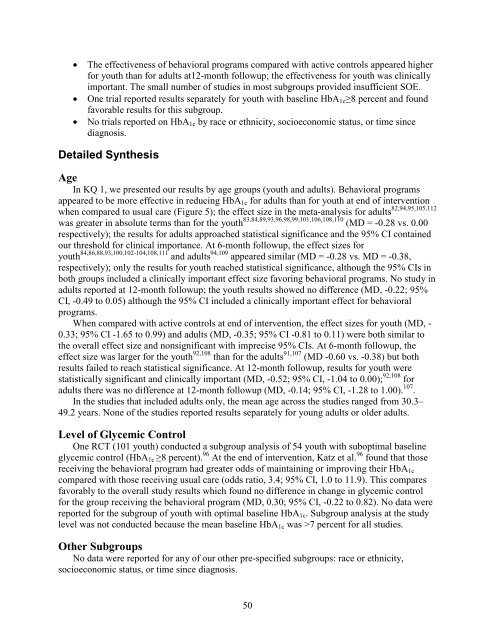Behavioral Programs for Diabetes Mellitus
diabetes-behavior-programs-report-150924
diabetes-behavior-programs-report-150924
- No tags were found...
You also want an ePaper? Increase the reach of your titles
YUMPU automatically turns print PDFs into web optimized ePapers that Google loves.
• The effectiveness of behavioral programs compared with active controls appeared higher<br />
<strong>for</strong> youth than <strong>for</strong> adults at12-month followup; the effectiveness <strong>for</strong> youth was clinically<br />
important. The small number of studies in most subgroups provided insufficient SOE.<br />
• One trial reported results separately <strong>for</strong> youth with baseline HbA 1c ≥8 percent and found<br />
favorable results <strong>for</strong> this subgroup.<br />
• No trials reported on HbA 1c by race or ethnicity, socioeconomic status, or time since<br />
diagnosis.<br />
Detailed Synthesis<br />
Age<br />
In KQ 1, we presented our results by age groups (youth and adults). <strong>Behavioral</strong> programs<br />
appeared to be more effective in reducing HbA 1c <strong>for</strong> adults than <strong>for</strong> youth at end of intervention<br />
when compared to usual care (Figure 5); the effect size in the meta-analysis <strong>for</strong> adults 82,94,95,105,112<br />
was greater in absolute terms than <strong>for</strong> the youth 83,84,89,93,96,98,99,101,106,108,110 (MD = -0.28 vs. 0.00<br />
respectively); the results <strong>for</strong> adults approached statistical significance and the 95% CI contained<br />
our threshold <strong>for</strong> clinical importance. At 6-month followup, the effect sizes <strong>for</strong><br />
youth 84,86,88,93,100,102-104,108,111 and adults 94,109 appeared similar (MD = -0.28 vs. MD = -0.38,<br />
respectively); only the results <strong>for</strong> youth reached statistical significance, although the 95% CIs in<br />
both groups included a clinically important effect size favoring behavioral programs. No study in<br />
adults reported at 12-month followup; the youth results showed no difference (MD, -0.22; 95%<br />
CI, -0.49 to 0.05) although the 95% CI included a clinically important effect <strong>for</strong> behavioral<br />
programs.<br />
When compared with active controls at end of intervention, the effect sizes <strong>for</strong> youth (MD, -<br />
0.33; 95% CI -1.65 to 0.99) and adults (MD, -0.35; 95% CI -0.81 to 0.11) were both similar to<br />
the overall effect size and nonsignificant with imprecise 95% CIs. At 6-month followup, the<br />
effect size was larger <strong>for</strong> the youth 92,108 than <strong>for</strong> the adults 91,107 (MD -0.60 vs. -0.38) but both<br />
results failed to reach statistical significance. At 12-month followup, results <strong>for</strong> youth were<br />
statistically significant and clinically important (MD, -0.52; 95% CI, -1.04 to 0.00); 92,108 <strong>for</strong><br />
adults there was no difference at 12-month followup (MD, -0.14; 95% CI, -1.28 to 1.00). 107 .<br />
In the studies that included adults only, the mean age across the studies ranged from 30.3–<br />
49.2 years. None of the studies reported results separately <strong>for</strong> young adults or older adults.<br />
Level of Glycemic Control<br />
One RCT (101 youth) conducted a subgroup analysis of 54 youth with suboptimal baseline<br />
glycemic control (HbA 1c ≥8 percent). 96 At the end of intervention, Katz et al. 96 found that those<br />
receiving the behavioral program had greater odds of maintaining or improving their HbA 1c<br />
compared with those receiving usual care (odds ratio, 3.4; 95% CI, 1.0 to 11.9). This compares<br />
favorably to the overall study results which found no difference in change in glycemic control<br />
<strong>for</strong> the group receiving the behavioral program (MD, 0.30; 95% CI, -0.22 to 0.82). No data were<br />
reported <strong>for</strong> the subgroup of youth with optimal baseline HbA 1c . Subgroup analysis at the study<br />
level was not conducted because the mean baseline HbA 1c was >7 percent <strong>for</strong> all studies.<br />
Other Subgroups<br />
No data were reported <strong>for</strong> any of our other pre-specified subgroups: race or ethnicity,<br />
socioeconomic status, or time since diagnosis.<br />
50


